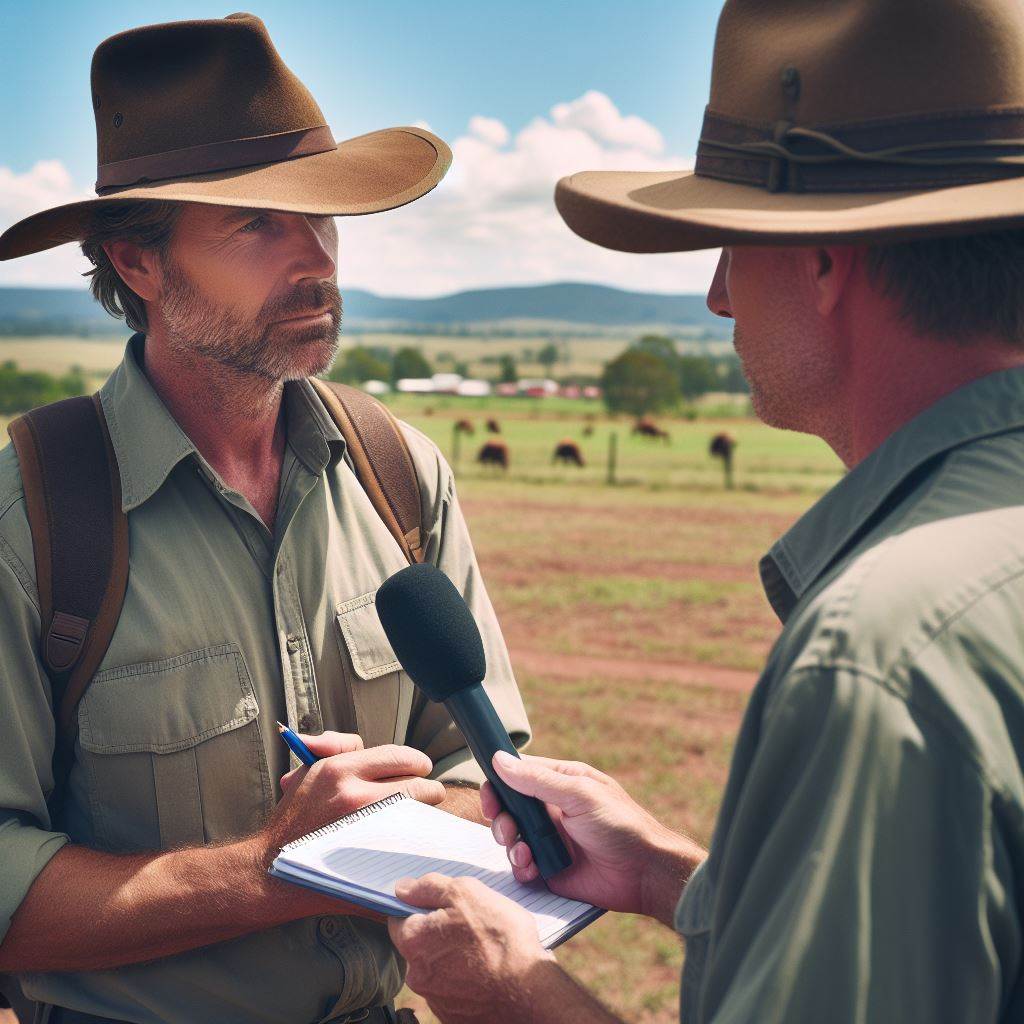Introduction
- Being an Aussie journalist entails the responsibility of reporting news and stories in Australia.
- Journalism is of utmost importance in Australia as it helps in maintaining transparency and democracy.
Explanation of what being an Aussie journalist entails
Being an Aussie journalist is no easy task. It involves the responsibility of reporting news and stories accurately and ethically in Australia. As journalists, we are the gatekeepers of information, playing a crucial role in disseminating news to the public.
Journalism holds immense importance in Australia. It serves as a pillar of democracy, ensuring that citizens are well-informed about current affairs and holding those in power accountable.
Our role as journalists is to uncover the truth, present diverse perspectives, and provide the public with the information they need to make informed decisions.
Importance of journalism in Australia
In Australia, journalism has played a vital role in shaping societal discourse. It has the power to spark change, challenge established norms, and give a voice to the marginalized. The press acts as a watchdog, exposing corruption, bringing to light social issues, and advocating for justice.
As an Aussie journalist, each day brings new challenges and opportunities. We tirelessly research, investigate, and report stories that impact our society.
Whether it’s covering political events, economic developments, or social issues, we strive to provide accurate, unbiased, and compelling news to our readers.
In this blog section, we will delve deeper into the life of an Aussie journalist. We will explore the rigorous process of gathering information, conducting interviews, navigating ethical dilemmas, and the constant search for truth.
So buckle up and get ready to experience a day in the life of an Aussie journalist.
Morning Routine
- Waking up early is crucial for an Aussie journalist to kickstart their day.
- They understand the importance of starting their day ahead of everyone else.
- Checking and responding to emails is one of the first tasks on their to-do list.
- They know that staying on top of communication is crucial in their field.
- Researching and staying updated on current events is a vital part of their morning routine.
- They immerse themselves in newspapers, online articles, and news broadcasts.
- Being well-informed allows them to provide accurate and up-to-date news to their audience.
- Preparing for interviews or press conferences is another essential aspect of their morning routine.
- They review background information and formulate relevant questions to ask.
- It ensures they are well-prepared to gather valuable insights from their sources.
Gathering News
As an Aussie journalist, my day starts with gathering news, which is a crucial part of my job. Here’s a glimpse into what it entails, from attending press briefings to collecting data and statistics.
Attending press briefings or events
One of the key activities I engage in as a journalist is attending press briefings or events. These are usually organized by government officials, organizations, or individuals to make important announcements or provide updates on current affairs.
As an active participant, I listen attentively and ask insightful questions to gather essential information.
Conducting interviews with sources
Another critical aspect of my job is conducting interviews. I reach out to various sources, including experts, witnesses, or individuals involved in significant events or stories.
Through face-to-face or phone interviews, I extract valuable insights, quotes, and opinions, enabling me to present a comprehensive and unbiased report to my readers.
Fact-checking and verifying information
Ensuring the accuracy and reliability of the information I gather is of utmost importance. Hence, fact-checking and verifying information is an essential task in my daily routine.
I meticulously cross-reference details, confirm facts with multiple sources, and scrutinize documents or data to eliminate any potential inaccuracies or biases.
Collecting relevant data and statistics
In order to provide an in-depth and well-rounded report, collecting relevant data and statistics is necessary. I delve into research, scour databases, and analyze official records to present quantifiable evidence and support my claims.
By incorporating data, I enhance the credibility and impact of my articles.
Basically, the process of gathering news as an Aussie journalist involves attending press briefings, conducting interviews with sources, fact-checking information, and collecting relevant data and statistics.
These fundamental activities enable me to deliver accurate, informative, and engaging news articles to my readers.
Writing and Editing
Organizing gathered information
- Collecting relevant data and facts from various sources to support the article’s content.
- Sorting and categorizing the gathered information to create a logical flow in the writing process.
- Creating an outline or structure that organizes the main points and supporting details.
- Identifying key elements that should be included and determining what can be left out.
Structuring the article or news segment
- Beginning the article with an engaging introduction that captures readers’ attention.
- Developing the main body by presenting information in a logical order and providing relevant examples.
- Using paragraphs and subheadings to break down text and make it easier to read.
- Using transitions to create smooth connections between ideas and ensure coherence.
Writing a captivating headline
- Creating a concise and informative headline that accurately reflects the article’s main idea.
- Using attention-grabbing words or phrases to attract readers and generate curiosity.
- Incorporating relevant keywords that optimize the article for search engine visibility.
- Avoiding sensationalism and false claims while still making the headline compelling.
Ensuring accuracy and clarity in writing
- Fact-checking all information before including it in the article to maintain credibility.
- Using clear and concise language to ensure readers can easily understand the message.
- Avoiding jargon and technical terms that may confuse or alienate the target audience.
- Double-checking grammar, spelling, and punctuation to maintain professional standards.
Collaborating with editors for revisions and improvements
- Sharing the draft with editors and receiving feedback on content, tone, and structure.
- Addressing and implementing the suggested revisions and improvements provided by the editors.
- Engaging in a constructive dialogue with editors to refine the article and enhance its quality.
- Working closely with the editorial team to ensure the final version meets publication standards.
Read: Music Production: A Guide for Aussies

Multimedia and Social Media
Including images, videos, or infographics in news reports
In today’s digital age, journalists have the power to enhance their news reports through compelling multimedia elements. Images, videos, and infographics not only add visual interest but also provide valuable context to the story.
Conducting live coverage through social media platforms
Social media platforms have revolutionized the way journalists cover breaking news. Through live coverage on platforms like Twitter and Facebook, journalists can provide real-time updates, share eyewitness accounts, and engage with their audience.
Engaging with the audience on social media
Social media has opened up new avenues for journalists to connect with their audience. Journalists can now actively engage with readers, answer questions, and address concerns, creating a more interactive and participatory news experience.
Your Personalized Career Strategy
Unlock your potential with tailored career consulting. Get clear, actionable steps designed for your success. Start now!
Get StartedPromoting articles or stories through various channels
Journalists market stories via social media platforms to enhance visibility and engagement with readers. They share content on platforms like Instagram, LinkedIn, and YouTube for wider reach. Including captivating multimedia elements enriches storytelling experiences.
Live coverage on social media provides immediate updates and immersive news experiences. Engaging with the audience fosters trust and community. Promoting articles across channels amplifies their impact.
Multimedia enriches storytelling, while live coverage enhances immediacy. Engaging with readers fosters trust. Promoting articles amplifies impact.
Read: How to Network in Australia’s Music Scene
Gain More Insights: The Business of Acting: A Guide for Aussies
Deadline Pressure
A day in the life of an Aussie journalist can be filled with stressful situations and tight deadlines.
One of the key challenges is prioritizing tasks and managing time efficiently.
Journalists are constantly working under pressure to meet editorial requirements and submit their stories on time.
They have to handle unexpected changes or breaking news that can disrupt their planned schedule.
It is essential for journalists to stay calm and composed while working against the clock.
Stressful situations and tight deadlines
- Journalists often encounter stressful situations while covering news stories.
- They have to gather information quickly and report it accurately.
- Meeting tight deadlines is crucial in the fast-paced world of journalism.
- Journalists thrive under pressure and are able to deliver quality work within limited time frames.
Prioritizing tasks and managing time efficiently
- Journalists need to juggle multiple tasks simultaneously.
- They prioritize stories based on their importance and relevance.
- Efficient time management helps them allocate sufficient time for researching, interviewing, and writing.
- They use tools and techniques to stay organized and meet their deadlines.
Working under pressure to meet editorial requirements
- Newspapers and media organizations have strict deadlines for publishing stories.
- Journalists must adhere to these deadlines to ensure their work reaches the intended audience on time.
- They collaborate with editors and colleagues to finalize their stories before the deadline.
- Working under pressure is a constant reality for journalists, and they have developed coping strategies to thrive in such situations.
Handling unexpected changes or breaking news
- Journalists are always prepared for unexpected changes or breaking news.
- They quickly adapt to new information and adjust their plans accordingly.
- When breaking news occurs, journalists put other tasks on hold to cover the developing story.
- They communicate effectively with their team to ensure everyone is aware of the changes and can adapt their work accordingly.
Meeting deadlines in journalism is a high-stakes challenge that requires resilience and effective time management.
Journalists thrive under pressure, constantly seeking the truth and delivering impactful stories to the world.
Despite the demanding nature of their job, Aussie journalists find fulfillment in the realization that their work informs and shapes public opinion.
Next time you read an article, appreciate the effort and dedication that went into meeting the deadline.
Read: Australian Music Awards: A Closer Look
Continuing Education and Professional Development
- Attending industry conferences or workshops allows Aussie journalists to stay updated on the latest trends and best practices.
- Engaging in ongoing training and skill enhancement programs helps journalists develop new abilities and stay competitive.
- Keeping up with new technologies and digital tools is essential for Aussie journalists to adapt to the evolving media landscape.
- Networking with other journalists and professionals provides valuable opportunities for collaboration and knowledge sharing.
Read: The Evolution of Australian Music Genres
Stand Out with a Resume That Gets Results
Your career is worth more than a generic template. Let us craft a resume and cover letter that showcase your unique strengths and help you secure that dream job.
Get HiredConclusion
Day in the life of an Aussie journalist
A day in the life of an Aussie journalist is both exciting and demanding. From early mornings chasing breaking news to late nights editing articles, their work is never done.
The importance of journalism in keeping the public informed cannot be overstated. Australian journalists play a vital role in society, digging deep to uncover the truth and holding those in power accountable.
Importance of journalism in keeping the public informed
However, this profession also comes with its challenges. Journalists often face risks, both physical and emotional, as they strive to bring important stories to light. The pressure to meet deadlines and deliver accurate information can be overwhelming at times.
Acknowledgment of the challenges and rewards in the profession
Despite the challenges, the rewards of being a journalist are immense. The ability to make a difference, to shed light on untold stories, and to give a voice to the voiceless is incredibly fulfilling.
Encouragement for aspiring journalists to pursue their passion
To aspiring journalists, I encourage you to pursue your passion. The world needs dedicated individuals who are willing to go the extra mile to uncover the truth. Embrace the challenges, embrace the rewards, and never stop seeking the stories that matter.




